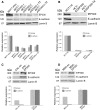Correction to: Tumour suppressor EP300, a modulator of paclitaxel resistance and stemness, is downregulated in metaplastic breast cancer
- PMID: 29305809
- PMCID: PMC6828501
- DOI: 10.1007/s10549-017-4633-6
Correction to: Tumour suppressor EP300, a modulator of paclitaxel resistance and stemness, is downregulated in metaplastic breast cancer
Abstract
In the original publication, Fig. 1 depicting the blot for EP300 in CAL51 cells (Fig. 1c) was unintentionally duplicated with that from MDA-MB-231 cells (Fig. 1d). The new figure given in this erratum depicts the correct EP300 blot in Fig. 1c.
Figures

Erratum for
-
Tumour suppressor EP300, a modulator of paclitaxel resistance and stemness, is downregulated in metaplastic breast cancer.Breast Cancer Res Treat. 2017 Jun;163(3):461-474. doi: 10.1007/s10549-017-4202-z. Epub 2017 Mar 24. Breast Cancer Res Treat. 2017. PMID: 28341962 Free PMC article.
Publication types
Grants and funding
LinkOut - more resources
Full Text Sources
Other Literature Sources
Miscellaneous

